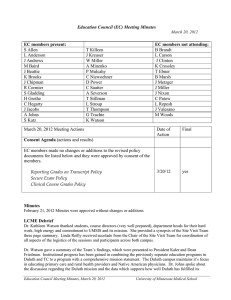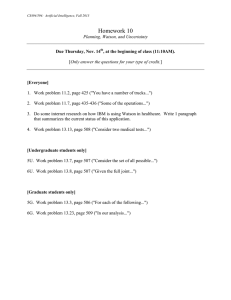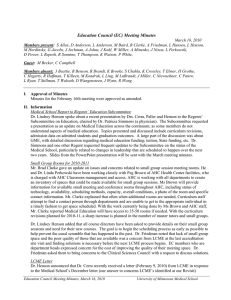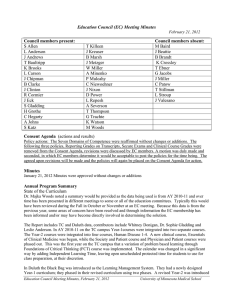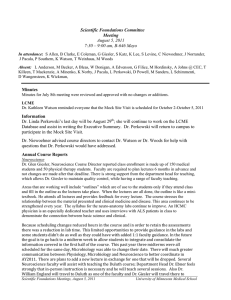Scientific Foundations Committee Meeting October 7, 2011
advertisement
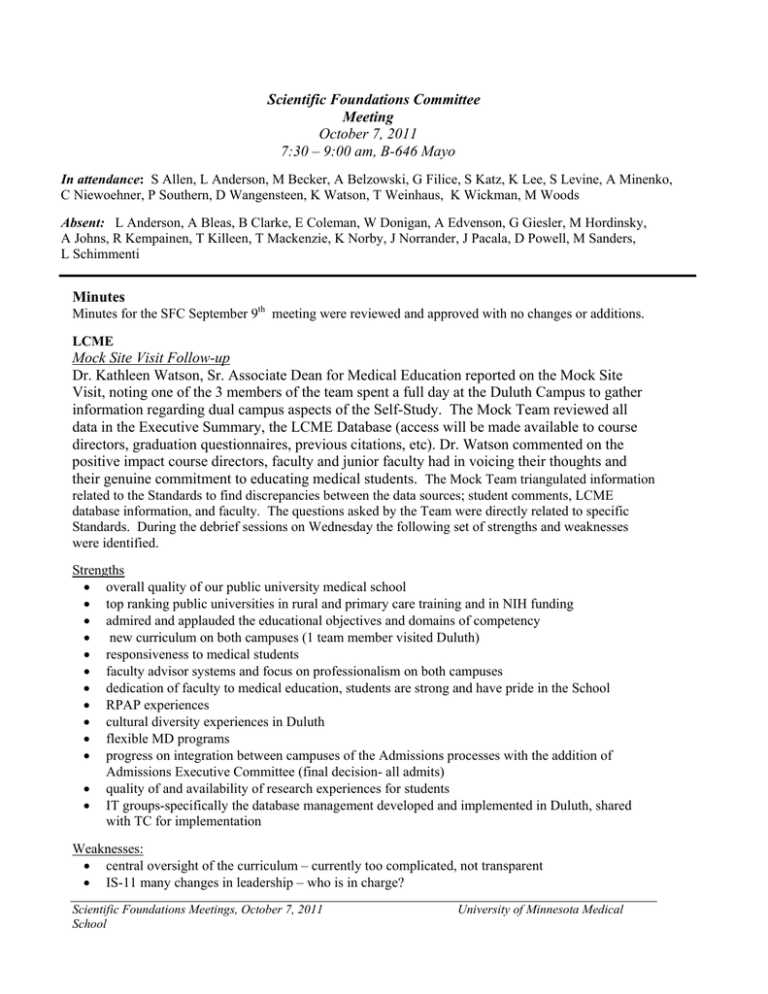
Scientific Foundations Committee Meeting October 7, 2011 7:30 – 9:00 am, B-646 Mayo In attendance: S Allen, L Anderson, M Becker, A Belzowski, G Filice, S Katz, K Lee, S Levine, A Minenko, C Niewoehner, P Southern, D Wangensteen, K Watson, T Weinhaus, K Wickman, M Woods Absent: L Anderson, A Bleas, B Clarke, E Coleman, W Donigan, A Edvenson, G Giesler, M Hordinsky, A Johns, R Kempainen, T Killeen, T Mackenzie, K Norby, J Norrander, J Pacala, D Powell, M Sanders, L Schimmenti Minutes Minutes for the SFC September 9th meeting were reviewed and approved with no changes or additions. LCME Mock Site Visit Follow-up Dr. Kathleen Watson, Sr. Associate Dean for Medical Education reported on the Mock Site Visit, noting one of the 3 members of the team spent a full day at the Duluth Campus to gather information regarding dual campus aspects of the Self-Study. The Mock Team reviewed all data in the Executive Summary, the LCME Database (access will be made available to course directors, graduation questionnaires, previous citations, etc). Dr. Watson commented on the positive impact course directors, faculty and junior faculty had in voicing their thoughts and their genuine commitment to educating medical students. The Mock Team triangulated information related to the Standards to find discrepancies between the data sources; student comments, LCME database information, and faculty. The questions asked by the Team were directly related to specific Standards. During the debrief sessions on Wednesday the following set of strengths and weaknesses were identified. Strengths overall quality of our public university medical school top ranking public universities in rural and primary care training and in NIH funding admired and applauded the educational objectives and domains of competency new curriculum on both campuses (1 team member visited Duluth) responsiveness to medical students faculty advisor systems and focus on professionalism on both campuses dedication of faculty to medical education, students are strong and have pride in the School RPAP experiences cultural diversity experiences in Duluth flexible MD programs progress on integration between campuses of the Admissions processes with the addition of Admissions Executive Committee (final decision- all admits) quality of and availability of research experiences for students IT groups-specifically the database management developed and implemented in Duluth, shared with TC for implementation Weaknesses: central oversight of the curriculum – currently too complicated, not transparent IS-11 many changes in leadership – who is in charge? Scientific Foundations Meetings, October 7, 2011 School University of Minnesota Medical ED-30 & 31: we need new policies to bring grade reporting for clerkships into compliance (4 weeks required by LCME) system is required to monitor clinical experience for gaps (evaluate data to identify priorities) results lead to curricular changes in clinical rotations --UMMS previously cited Provide mid-rotation evaluation for all courses (all students) to identify problems/gaps with enough time remaining to correct problem(s). Process for evaluating gaps in clinical courses ready to implement (PX DX System) -will improve monitoring, replaces current paper records). Due to previous citation – risk is relative to progress achieved by December, 2011 Residents as teachers –provide substantial % of teaching, their orientation must include the Domains of Competencies, course learning objectives, methods for teaching, and skillful methods for feedback to students. Documentation of orientation and training requires tracking, GME will also participate Lounge, study and group space; at risk due to previous citation; budget established to improve Computer lab; Student Council developing plans to rework the Adytum to address deficiency Required for every course and every student: Yr 1-4 on both campuses; narrative description/ summary statement for their learning experience and outcomes achieved Adequate clerkship sites; students dissatisfied with the scheduling of electives and away rotations (Thompson, Fritts, Watson are addressing the concerns and working with Student Council); some sites have eliminated slots over time Duluth – number of faculty, previously cited, there is a hiring plan in place and active searches in progress; there is risk of citation; regards to joint position of Dean and Vice President for AHC; is under review by Regents IS-16 understanding and demonstrating diversity as it exists in the State of MN and how it affects our contribution to diversity --potentially educationally disadvantaged individuals, very small community residents, refugee groups and immigrants); develop definition of diversity that also meets our mission (medical school specific); also look at level of diversity of faculty For LCME Standard ED-32, requires a non-cognitive evaluative statement for every student (years 1-4); the consultants pointed out we are out of compliance. Dr. Watson requested that course directors bring suggestions and examples for how faculty can accomplish the evaluation in a standardized process. Several faculty suggested steps they currently use in a less formal process within their courses could be adapted. Dr. Watson noted a very important piece of advice from consults which states “if it isn’t documented it didn’t happen” as a guide to use processes that can be readily documented. Suggestions included the following: -centralize across all courses, personal cumulative assessment information for ea. Student -professionalism -identify exceptional and/or poor performances -contributions through small groups, labs, written materials Discussion will be more detailed at the November meeting, examples of clerkship evaluations will illustrate how it has been done for rotations. Dr. Watson spoke about the ED Standards that require a variety of learning experiences (fewer lectures) in every course, making active learning more common in all courses. Other added considerations include the timing for submitting the narrative, i.e. HD course directors may need input from their course faculty to be able to synthesize non-cognitive performance across their course. For anyone attending the AAMC annual meeting there will be opportunities to ask colleagues how their schools are accomplishing this requirement. There was a brief discussion about the Mock Team’s highly positive view of our Domains of Competence used as the guide for the UMMS. Course directors were encouraged to contact Scientific Foundations Meetings, October 7, 2011 School University of Minnesota Medical individuals they know at other medical schools to get ideas about methods. Curriculum Suggestions for discussion include: setting a consistent method for student non-cognitive evaluation across all courses apply the Domains of Competency as a guide for skills other than knowledge to provide direction for evaluation educate students about the Domains of Competency and how they impact their education can provide better understanding for how they are preparing to become doctors through non-cognitive evaluation and broader application of Domains of Competence, students may be more reflective in assessing how they approach their own learning, the range of actions they take in terms of their own curiosity and in their overall learning It is necessary to meet this Standard in a way that is an added value for UMMS students. Student representatives felt it would be valuable in focusing their participation in small groups, knowing that they were being assessed more individually and critically. They are also interested in how it will be organized and how it can broaden their relationship with faculty. Discussion included concerns from course directors for ways to manage the process for non-cognitive evaluation. Consensus is to have a comprehensive discussion of Policy, procedures and process (Narrative summary of students’ performance) in-group, interactive learning, patient-present, cdc’s, team based learning, i.e. peer assessment is an example for determining aspects of student learning and interactions that are not a part of knowledge assessment. Dr. Watson noted accomplishing compliance and added value will require a partnership between faculty and students. Information Education Steering Committee (ESC) Dr. Katz reported the ESC has begun to look at integration across the curriculum. This has occurred in the past but during review of LCME Standards, it was found that ED-2, -33, 34, 35 and 37 all address integration and UMMS is not compliant with requirements. ESC has drafted a proposal for content oversight, curriculum evaluation and horizontal and vertical integration in a specific and formal process. This has been done informally, but the proposal is designed to meet LCME Standards (listed above). It is proposed by adding a new role to the Oversight structure and naming the former Curriculum Committee as the Curriculum Evaluation and Integration Committee (CEIC). They charge will be to perform ongoing reviews of the entire curriculum on both campuses, with integration as the focus. This process will put the review on a 7- year cycle, making it thorough and consistent; prioritizing a few themes to be reviewed annually. Of immediate concern are gaps and redundancies and will be addressed first. The former Integration Work Groups (IWGs) will be regenerated around specific areas to determine where there are gaps and redundancies; the Curriculum Database will aid the CEIC in reviewing and identifying the deficient areas. Students are often frustrated with redundancies without a clear understanding for the importance of the subject matter in medical practice. The Domains of Competence and the Clerkship Objectives will aid in the review process. The goal is to reactivate the IWGs very soon and complete pilot reviews for several areas. Dr. Watson reported that all of the mapping in the Curriculum Database for Years 1 and 2 is complete and, mapping for Years 3 and 4 will be completed by mid-December. A demonstration will be done for a meeting in the near future. Course directors asked what role the SFC is charged to perform. Dr. Niewoehner noted SFC members discuss problems common to all courses, policy discussions and implementation procedures. SFC meets for information sharing which at times includes action by the ESC. ESC is working on how the groups will operate to help provide a functional format and because of the current preparation for the Site Visit, establish priorities to target before March 2012. With use of the Curriculum Management Database (curriculum mapping) Dr. Katz reports it should be possible for pilot IWGs to identify a few of the gaps and discrepancies within 1 or 2 brief meetings. For ED-33 a version of Central Oversight would mean the ability to pull all evaluation data (graduation questionnaire, student comments, course reviews, student performance, etc.) together for a course (Site Visit Team will ask about each course) and triangulating that information to review Scientific Foundations Meetings, October 7, 2011 School University of Minnesota Medical it. Course content will be loaded into the Database for future expanded use. Testing is currently being done to clarify if course objectives, session objectives across all four years will fit into the IT rubric that was developed on the Duluth campus. Discussion Independent Learning Time SFC members reported on their methods of directing student use of Independent Learning Time (ILT). In Gross Anatomy all contact time is in the lab and students have to come prepared in order to progress. At the beginning of Gross Anatomy students are informed during the Course Orientation of the resources and how the resources can aide their preparation for lab sessions. They have several preparation choices found on the course website; pre recoded lectures, lecture notes, slides, lab notes and course notes linked to other resources. There are pre-lab assignments which are discussed at lab sessions; students turn them in and they are tracked. Shortly after the course begins students realize if they work through the assignments and understand them, lab sessions are productive and they successfully complete the course. ECM has preparation information sheets (no lectures) which list what students need to do to be prepared; included are readings, videos demonstrating physical exam, quizzes, and radiographs they can review. The plan is generally about 2 hours of prep per ½ day session. For the HD2 course, a new approach is designed to use self-study questions as “readiness questions”. The questions will be made available for student access for a certain period of time before a session is held. This is to create a timeframe for pre-class preparation, questions are relevant to the upcoming session; access timing will limit their use. Weekly they’ll receive a reflection assignment that is not linked to a session, but to an interactive learning experience (a component of structured interactive learning). This will be read and graded as either “meets expectations, exceeds expectations or below expectations” and may be used to develop narrative evaluations. Dr. Minenko considers use of weekly plans, which include directed preparation, as necessary for a 10-week course. This serves to tie the pieces of knowledge together. Mileposts as guidelines for students to know if their progress is appropriate for the course. Student representatives report positive experiences for courses that have clear expectations for what they should learn session by session. In discussing general use of review sessions for courses, are useful as reported by student representatives. Faculty noted that review sessions are productive, but to use ILT would, over a short time, eliminate ILT. Protected time would be filled with course specific activities. Education Council has determined no reviews will be held during ILT. Other items along with interactive learning, small groups, and guided ILT that aid student learning, are appropriate reading resources. Providing good reading resource information, as “additional” related materials, allows students to make use of well focused information. Across all courses there is a need to develop consistency for what is required in preparation for lectures, small groups and labs. Methods for preparation should be applied course-by-course; developed by the course director, with the following suggested guidelines: level of preparedness should be explicitly defined and communicated at the beginning of the course explicit session by session information communicate explicitly what materials should be used to be prepared for a given session conclusion of session, provide a mini formative assessment to guide students on their progression student objective is to know where they have “gaps” and to fill those gaps through interactive learning, lectures, labs, etc. Scientific Foundations Meetings, October 7, 2011 School University of Minnesota Medical work with faculty in the course block to provide feedback to students using methods that aren’t overwhelming to students (especially to Yr-1) Next Meeting: SFC November 4, 2011 CANCELLED Curriculum Committee Meeting November 11th Scientific Foundations Meetings, October 7, 2011 School University of Minnesota Medical
